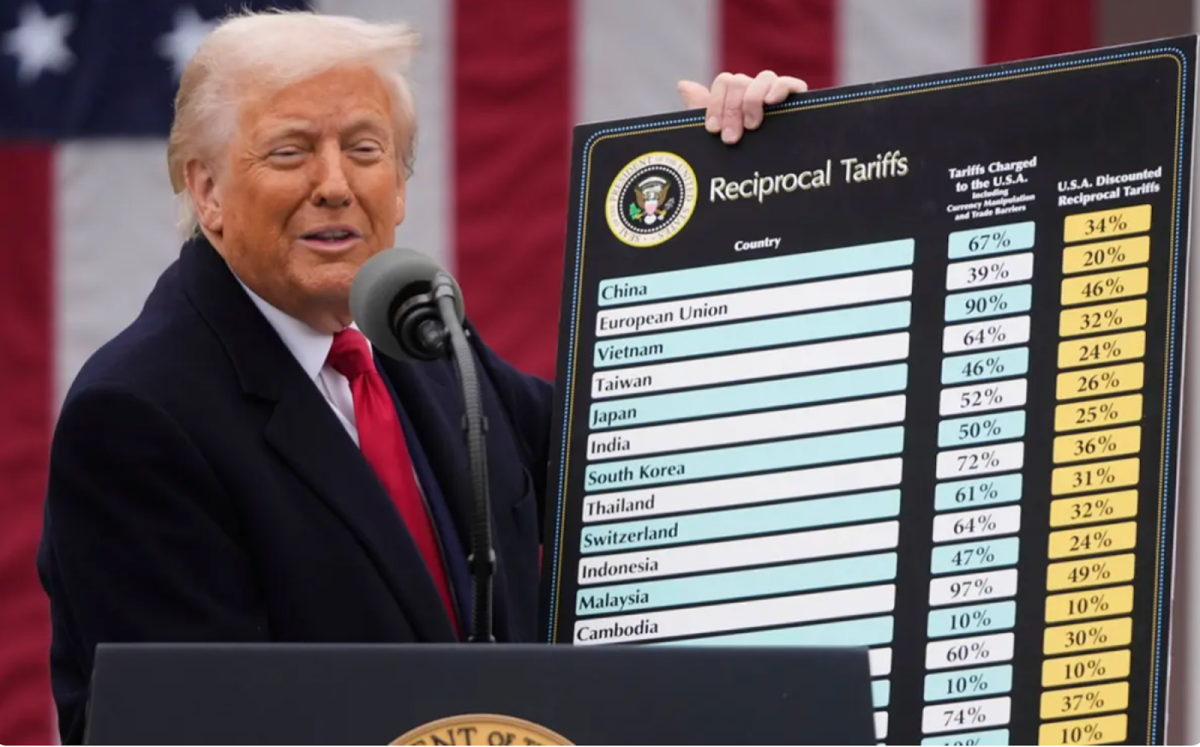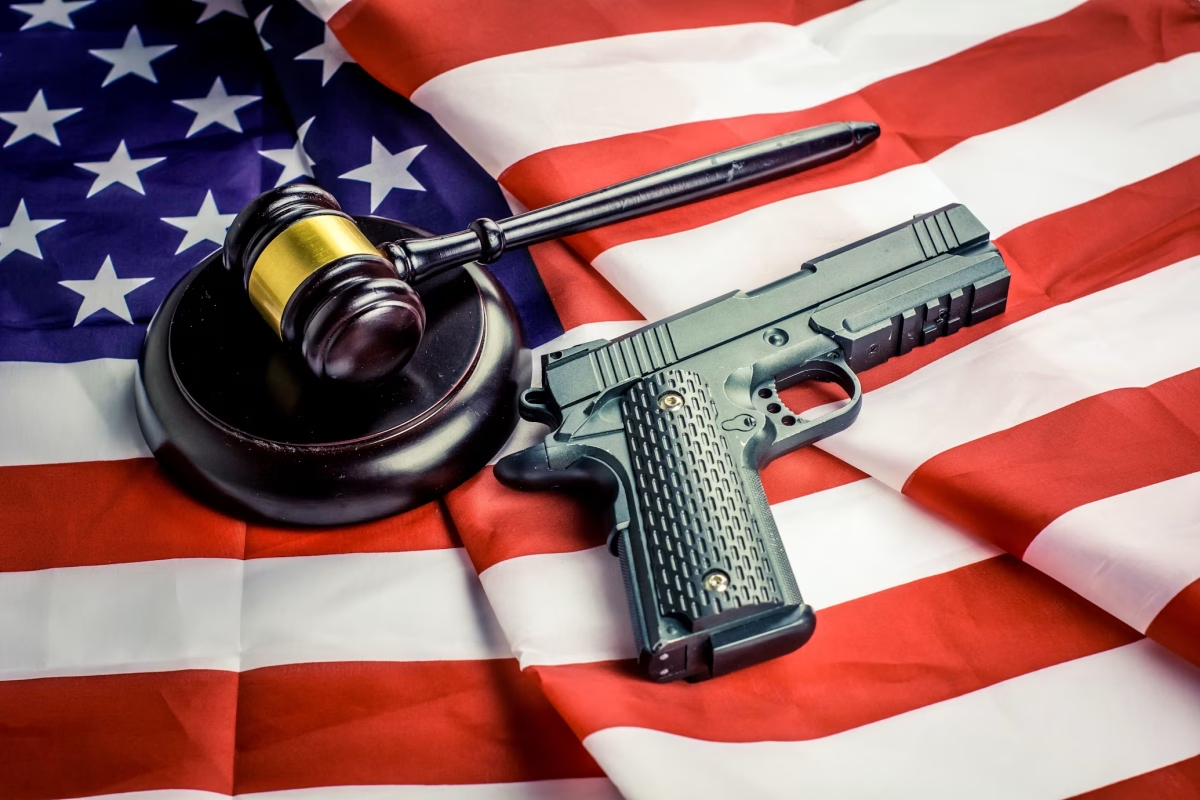Tariffs are taxes on imported goods. They raise prices and increase production costs for manufacturers who rely on foreign parts, making U.S. industry less competitive.
The U.S. has a troubled history with tariffs. The 1930 Smoot-Hawley Tariff caused a 60% reduction in international trade, exacerbated the Great Depression, and devastated millions of Americans. Similarly, the tariffs implemented by President Richard Nixon in the 1970s helped trigger the era of stagflation (high inflation during an economic downturn), providing a clear historical record of the damage tariffs can inflict.
Nevertheless, on April 2, 2025, President Trump enacted a 10% tariff on all products from 125 countries and “reciprocal” tariffs on 60 additional nations. These “reciprocal” tariffs were calculated using a formula economists speculate was created by Artificial Intelligence: tariff = (trade deficit/imports)/2. In his Liberation Day speech, he declared, “For decades, our country has been pillaged, looted, raped, and plundered by nations near and far, friend and foe alike.”
Instead of grounding his policy in data, Trump leaned on weaponized nationalism, victimhood, and anger toward so-called “economic rapists and looters”.
Additionally, the Trump tariffs lacked constitutional grounding. Under Article I, Section 8, Congress, not the President, regulates trade. Yet Trump claimed authority under Section 301 of the 1974 Trade Act to impose tariffs on countries engaging in unfair trade practices. Many targeted countries had no trade barriers on U.S. goods, making it unclear how they violated Section 301’s standard of “unfair trade practices.”
Yet despite its emotional appeal, one must ask: Is Trump’s narrative rooted in fact or fiction?.
Trump inherited a robust economy known for its exceptional recovery from COVID-19 relative to the rest of the world. According to the Federal Reserve and the Bureau of Economic Analysis, inflation was finally below 3%, unemployment was around 4%, and GDP growth was at 2.4% in 2024. The fundamental bread and butter issue facing Americans was not a trade conspiracy by the rest of the world to metaphorically rape, loot, and pillage the U.S. through free trade. According to the Brookings Institution and the Ludwig Institute for Economic Prosperity, the real issues were high prices, exclusion, class-based inequality, and housing shortages.
Furthermore, basing tariffs on trade deficits, as Trump does in his formula, is a widely rebuked trade policy. Economist David Ricardo explains, “Countries specialize in producing goods where they have a comparative advantage, enabling them to produce more efficiently and trade for other goods they need, ultimately benefiting all parties involved.”
An analogy for this would be paying $20 for my haircut (my import), creating a ‘trade deficit.’ But I afford it by cleaning houses—my comparative advantage. Trump’s logic would tax my haircut because he believes I’m being “looted” by imports. Trade deficits shrink not through tariffs but by raising taxes or cutting spending on entitlements, reducing consumerism, defense, or both.
Of course, economists weren’t consulted—so five days later, on April 7, 2025, at 12:07 p.m., the Dow dropped 10%, the S&P over 10%, and the NASDAQ over 10%.
This wiped out trillions in retirement savings, shook consumer confidence, and could trigger job losses. In fact, since Trump’s inauguration, more than $9 trillion in U.S. markets have been wiped out.
Some defended the pain. Judge Jeanine Pirro, Trump’s Fox News ally worth $14 million, defended him on air, “You know what, I don’t care about my 401k today; you know what, not that I can afford it, not that it isn’t important, not that I’m not at a point in my life when I should be worried about my 401k”
For a veteran in Bethlehem or a trucker in Allentown, crashing the economy isn’t just a cause for being “worried”—it means losing healthcare, retirement, and economic security. Their livelihoods shouldn’t be gambled away on the whims of a single leader, regardless of what Pirro says from her multimillion-dollar perch at Fox.

Despite the outcomes, Trump proclaimed in his speech, “With today’s actions, we will finally be able to make America great again, greater than ever before. Jobs and factories will come crawling back to our country,” believing tariffs would revive domestic manufacturing and cut foreign consumption.
This vision oversimplifies supply chains—most U.S. products rely on imports, and such tariffs risk harming manufacturers more than helping.
An analogy for this vision, where everything is made in the U.S., would be growing your food, building your own home, and crafting all your appliances. It’s more efficient to focus on what you do best, earn money from it, and trade for what others can produce more effectively. Refusing to buy from others means they can’t afford to buy from you, driving everyone, including yourself, toward bankruptcy.
Case in point, on April 3, 2025, Canada retaliated against Trump’s other tariffs with a 25% tariff on the U.S. auto industry.
“The old relationship we had with the United States, based on deepening integration of our economies and tight security and military cooperation, is over,” stated Canada’s new Prime Minister, Mark Carney. “We will need to dramatically reduce our reliance on the United States; we will pivot our trade relationships elsewhere.”
China also imposed a 34% tariff on all U.S. imports, and the EU pledged retaliation against U.S. tech companies.
Republican Senators Rand Paul, Mitch McConnell, Lisa Murkowski, and Susan Collins, along with all 47 Democrats in the Senate, voted to weaken Trump’s tariff powers. Trump has said he will veto that bill.
Senator Rand Paul said, “Not only are tariffs bad economically, but it’s inappropriate for a constitutional republic to allow one person to raise taxes.”
He cautioned Americans about Trump’s abuse of power and the resulting economic damage.
Independent industries have power. The tariffs are Trump’s tool to erode that independence,” Democratic Senator Chris Murphy stated on X.. “Now, every industry or company will need to pledge loyalty to Trump to obtain sanctions relief.”
A study by Lehigh University revealed that in Trump’s last term, getting tariff waivers was heavily linked to whether they were connected to Republican political campaigns.
Pennsylvania Republican Senator Dave McCormick, along with 48 Republicans in the Senate, voted to protect Trump’s tariff powers, claiming on CNBC, “What is happening here is to address unfairness and also bring back a much stronger manufacturing base in the United States.”
However, in 2019, McCormick criticized Trump’s trade war with China, calling it a shift from a market-access discussion on tariffs to the “weaponization of exports.”
Vice President JD Vance also favored Trump’s tariffs, saying they were necessary to combat “the globalist” economy and accusing “Chinese peasants” of taking American manufacturing jobs. However, Vance also stated in 2017, “If you’re worried about America’s economic interest, focus more on automation/education than trade protectionism.”
On April 9, 2025, bond markets collapsed due to massive treasury sell-offs, indicating the United States was headed for an economic crisis amplified by a debt crisis and lack of capital flows due to low trust.
Several hours later, Trump posted on Truth Social, “It is a great time to buy.”
Three hours later, he broke news saying he had paused reciprocal tariffs, except on China, for 90 days. Therefore, while most tariffs are gone, 10% remain on every country, 25% on Mexico, 25% on Canada, and 245% on China. As a result, the stock market temporarily boomed due to tariff relief. Yet damage to the bond and stock market has not been fully reversed. China has also increased tariffs on US goods to 125% and halted all exports of rare earth elements (RREs) to the USA. RREs are critical to tech. China’s near-monopoly (90% refining, 69% production) puts the U.S. in a precarious spot.
On April 12th, Trump stated that he’d consider company-specific tariff relief. When asked about how tariff relief would be decided, he commented, “instinctively.” This statement increased concerns over whether or not the president would weaponize tariff relief to erode private sector independence. Trump then selectively granted tariff relief to big tech—coincidentally, the same companies whose CEOs donated to and attended his inauguration.
Soon after, Vietnam moved quickly to appease the Trump administration, granting Elon Musk’s Starlink permission to operate in the country and fast-tracking approval for a new Trump real estate project.
A strong show of putting American workers first, right?
On April 22, 2025, after the economy slowed and trillions were lost, Trump said he would significantly reduce tariffs on China—effectively conceding in the trade war he had triggered without clear justification.
As of writing, Trump has said tariffs will pay off the national debt, eliminate imports, rebuild U.S. manufacturing, and somehow make other countries pay for it all, even as he admits tariffs hurt some companies and promises selective relief. Nothing is clear—it’s a tangle of contradictions, built on untruths. That’s the point: flood the zone, sow chaos, blur truth—so no one can respond.
Then Trump can do anything he wants—consolidate power over the private sector, offload tax cuts for the rich onto the working class, or even push a Maoist fantasy of total self-sufficiency. Or maybe it’s just extreme corruption. We don’t know. That’s the danger: by flooding the public sphere with contradictions and conspiracy, Trump dulls our ability to distinguish fact from fantasy. And that confusion becomes his shield. Thankfully, truth still cuts through that shield. According to the Yale Budget Lab, these tariffs will cost American households a yearly average of $4,900. That’s three months of rent, a year of groceries, or almost three years of gas. Can you afford to pay that much more every year? Because this ain’t just rhetoric, this is your life.





![The Downfall of Taylor Swift: AI, ‘The Life [and Demise] of a Showgirl’](https://comenian.org/wp-content/uploads/2025/10/unnamed-6-1.jpg)







